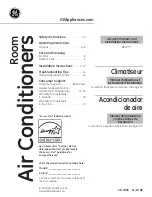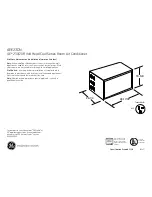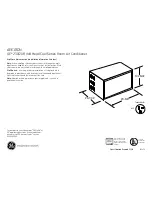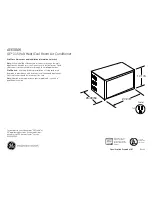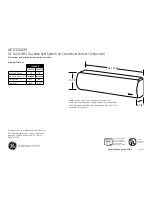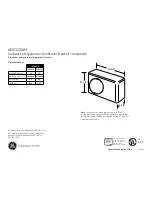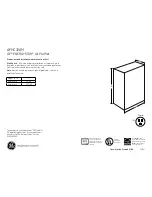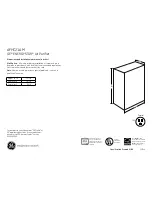
25
DIMENSIONAL DRAWINGS AND INSTALLATION DATA
CONTINUED
VOLTAGE
CURRENT
DIMENSIONS --- Inches (mm)
PLUG TYPE
VOLTS
AMPS
X
Y
Z
NEMA PLUG
NEMA
RECEPTACLE
SUPPLIER 1
SUPPLIER 2
SUPPLIER 1
SUPPLIER 2
208/230
15
58 (1473)
2.36 (60)
2.44 (62)
3.35 (85)
4 (101)
6--- 15P
6--- 15R
208/230
20
58 (1473)
2.36 (60)
2.44 (62)
3.35 (85)
4 (101)
6--- 20P
6--- 20R
208/230
30
58 (1473)
2.55 (65)
4 (101)
2.63 (67)
3.8 (96)
6--- 30P
6--- 30R
265
15
15 (381)
1.5 (38.2)
1.46 (37.3)
7--- 15P
7--- 15R
265
20
15 (381)
2 (50)
2.48 (63.2)
7--- 20P
7--- 20R
265
30
15 (381)
2.41 (61.3)
7--- 30P
7--- 30R
42"
(1067)
`
ACCESSORY
WALL SLEEVE
HINGED CONTROL
ACCESS DOOR
DISCHARGE
GRILLE
REMOVABLE
FRONT PANEL
Y
Z
X
208/230V
Accessory Service Cord
A08388
Front View
A07379A
Side View
GA
5
APPLICATION CONSIDERATIONS
Installation instructions are shipped with all PTAC
units. It is important that air conditioning systems be
properly sized and installed for each application in
order to achieve the desired temperature and humidity
levels within the space to be conditioned. It is
strongly recommended that a professional engineer
match the PTAC units with the building structure and
climate.
The following application considerations are all
important in choosing the proper PTAC system for
the building structure.
Undersizing
If a PTAC unit is undersized (cooling capacity is less
than required load for an application), the unit
will not be able to cool the space down to the desired
temperature during very hot days. The result could be
warm and humid or warm and dry conditioned space.
Oversizing
If a PTAC unit is oversized (cooling capacity is
greater than required load for the specific application),
the unit will cool the space down to the desired
desired temperature too quickly.
The unit will cycle on and off, however,
dehumidification only takes place when the unit is
operating. The result of this type of application in a
hot and/or humid climate would be a cool, yet
excessively humid, space.
Air Infiltration
Excessive air infiltration can intensify problems
associated with undersizing or oversizing a PTAC
unit. This can be the cause of insufficient cooling,
dehumidification, or heating. Sources of air
infiltration include vents, gaps around windows and
doors, and improperly sealed floors, ceilings or wall
joints.
GA
Condensate Removal
Gree’s GA series has a new condensate (water)
disposal system. The outdoor fan prop has a built in
slinger ring which draws condensate water through a
suction port built into the outdoor coil shroud. The
water passes though the suction port and is sprayed
on the warm outdoor coil for evaporation. Thus
providing better disposal of excess condensate and
improving unit operating efficiency.
It is normal and desirable to have some condensate
water in the ebase pan to boost operating efficiency.
NOTE: This unit will not always evaporate 100%
of the unit generated condensate and blown in
rain water. If it is necessary to control 100% of
the condensate, the Drain Kit (Part No.: DRAIN-
KIT-4PK) and a building condensate drain
system is recommended.


































